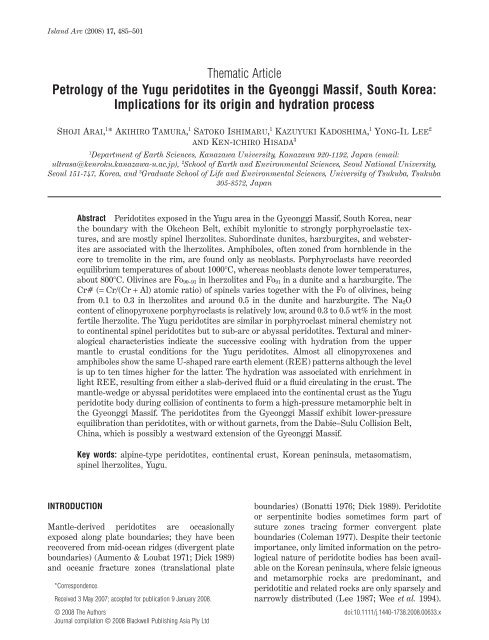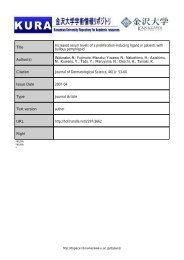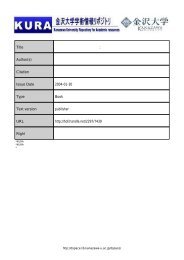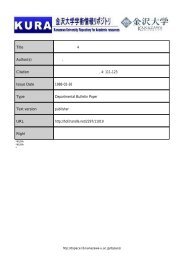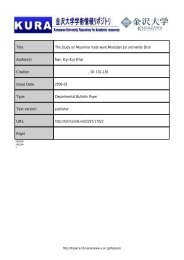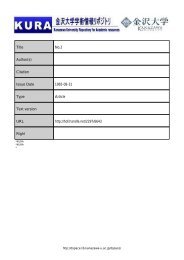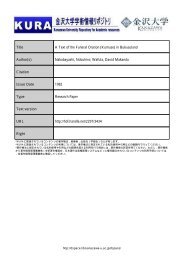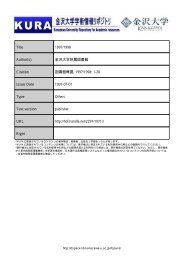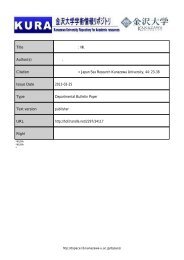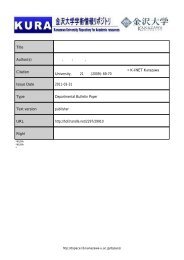Petrology of the Yugu peridotites in the Gyeonggi Massif, South Korea
Petrology of the Yugu peridotites in the Gyeonggi Massif, South Korea
Petrology of the Yugu peridotites in the Gyeonggi Massif, South Korea
Create successful ePaper yourself
Turn your PDF publications into a flip-book with our unique Google optimized e-Paper software.
Island Arc (2008) 17, 485–501<br />
Thematic Article<br />
<strong>Petrology</strong> <strong>of</strong> <strong>the</strong> <strong>Yugu</strong> <strong>peridotites</strong> <strong>in</strong> <strong>the</strong> <strong>Gyeonggi</strong> <strong>Massif</strong>, <strong>South</strong> <strong>Korea</strong>:<br />
Implications for its orig<strong>in</strong> and hydration process<br />
SHOJI ARAI, 1 *AKIHIRO TAMURA, 1 SATOKO ISHIMARU, 1 KAZUYUKI KADOSHIMA, 1 YONG-IL LEE 2<br />
AND KEN-ICHIRO HISADA 3<br />
1 Department <strong>of</strong> Earth Sciences, Kanazawa University, Kanazawa 920-1192, Japan (email:<br />
ultrasa@kenroku.kanazawa-u.ac.jp), 2 School <strong>of</strong> Earth and Environmental Sciences, Seoul National University,<br />
Seoul 151-747, <strong>Korea</strong>, and 3 Graduate School <strong>of</strong> Life and Environmental Sciences, University <strong>of</strong> Tsukuba, Tsukuba<br />
305-8572, Japan<br />
INTRODUCTION<br />
Abstract Peridotites exposed <strong>in</strong> <strong>the</strong> <strong>Yugu</strong> area <strong>in</strong> <strong>the</strong> <strong>Gyeonggi</strong> <strong>Massif</strong>, <strong>South</strong> <strong>Korea</strong>, near<br />
<strong>the</strong> boundary with <strong>the</strong> Okcheon Belt, exhibit mylonitic to strongly porphyroclastic textures,<br />
and are mostly sp<strong>in</strong>el lherzolites. Subord<strong>in</strong>ate dunites, harzburgites, and websterites<br />
are associated with <strong>the</strong> lherzolites. Amphiboles, <strong>of</strong>ten zoned from hornblende <strong>in</strong> <strong>the</strong><br />
core to tremolite <strong>in</strong> <strong>the</strong> rim, are found only as neoblasts. Porphyroclasts have recorded<br />
equilibrium temperatures <strong>of</strong> about 1000°C, whereas neoblasts denote lower temperatures,<br />
about 800°C. Oliv<strong>in</strong>es are Fo90–91 <strong>in</strong> lherzolites and Fo91 <strong>in</strong> a dunite and a harzburgite. The<br />
Cr# (= Cr/(Cr + Al) atomic ratio) <strong>of</strong> sp<strong>in</strong>els varies toge<strong>the</strong>r with <strong>the</strong> Fo <strong>of</strong> oliv<strong>in</strong>es, be<strong>in</strong>g<br />
from 0.1 to 0.3 <strong>in</strong> lherzolites and around 0.5 <strong>in</strong> <strong>the</strong> dunite and harzburgite. The Na2O<br />
content <strong>of</strong> cl<strong>in</strong>opyroxene porphyroclasts is relatively low, around 0.3 to 0.5 wt% <strong>in</strong> <strong>the</strong> most<br />
fertile lherzolite. The <strong>Yugu</strong> <strong>peridotites</strong> are similar <strong>in</strong> porphyroclast m<strong>in</strong>eral chemistry not<br />
to cont<strong>in</strong>ental sp<strong>in</strong>el <strong>peridotites</strong> but to sub-arc or abyssal <strong>peridotites</strong>. Textural and m<strong>in</strong>eralogical<br />
characteristics <strong>in</strong>dicate <strong>the</strong> successive cool<strong>in</strong>g with hydration from <strong>the</strong> upper<br />
mantle to crustal conditions for <strong>the</strong> <strong>Yugu</strong> <strong>peridotites</strong>. Almost all cl<strong>in</strong>opyroxenes and<br />
amphiboles show <strong>the</strong> same U-shaped rare earth element (REE) patterns although <strong>the</strong> level<br />
is up to ten times higher for <strong>the</strong> latter. The hydration was associated with enrichment <strong>in</strong><br />
light REE, result<strong>in</strong>g from ei<strong>the</strong>r a slab-derived fluid or a fluid circulat<strong>in</strong>g <strong>in</strong> <strong>the</strong> crust. The<br />
mantle-wedge or abyssal <strong>peridotites</strong> were emplaced <strong>in</strong>to <strong>the</strong> cont<strong>in</strong>ental crust as <strong>the</strong> <strong>Yugu</strong><br />
peridotite body dur<strong>in</strong>g collision <strong>of</strong> cont<strong>in</strong>ents to form a high-pressure metamorphic belt <strong>in</strong><br />
<strong>the</strong> <strong>Gyeonggi</strong> <strong>Massif</strong>. The <strong>peridotites</strong> from <strong>the</strong> <strong>Gyeonggi</strong> <strong>Massif</strong> exhibit lower-pressure<br />
equilibration than <strong>peridotites</strong>, with or without garnets, from <strong>the</strong> Dabie–Sulu Collision Belt,<br />
Ch<strong>in</strong>a, which is possibly a westward extension <strong>of</strong> <strong>the</strong> <strong>Gyeonggi</strong> <strong>Massif</strong>.<br />
Key words: alp<strong>in</strong>e-type <strong>peridotites</strong>, cont<strong>in</strong>ental crust, <strong>Korea</strong>n pen<strong>in</strong>sula, metasomatism,<br />
sp<strong>in</strong>el lherzolites, <strong>Yugu</strong>.<br />
Mantle-derived <strong>peridotites</strong> are occasionally<br />
exposed along plate boundaries; <strong>the</strong>y have been<br />
recovered from mid-ocean ridges (divergent plate<br />
boundaries) (Aumento & Loubat 1971; Dick 1989)<br />
and oceanic fracture zones (translational plate<br />
*Correspondence.<br />
Received 3 May 2007; accepted for publication 9 January 2008.<br />
© 2008 The Authors<br />
Journal compilation © 2008 Blackwell Publish<strong>in</strong>g Asia Pty Ltd<br />
boundaries) (Bonatti 1976; Dick 1989). Peridotite<br />
or serpent<strong>in</strong>ite bodies sometimes form part <strong>of</strong><br />
suture zones trac<strong>in</strong>g former convergent plate<br />
boundaries (Coleman 1977). Despite <strong>the</strong>ir tectonic<br />
importance, only limited <strong>in</strong>formation on <strong>the</strong> petrological<br />
nature <strong>of</strong> peridotite bodies has been available<br />
on <strong>the</strong> <strong>Korea</strong>n pen<strong>in</strong>sula, where felsic igneous<br />
and metamorphic rocks are predom<strong>in</strong>ant, and<br />
peridotitic and related rocks are only sparsely and<br />
narrowly distributed (Lee 1987; Wee et al. 1994).<br />
doi:10.1111/j.1440-1738.2008.00633.x


